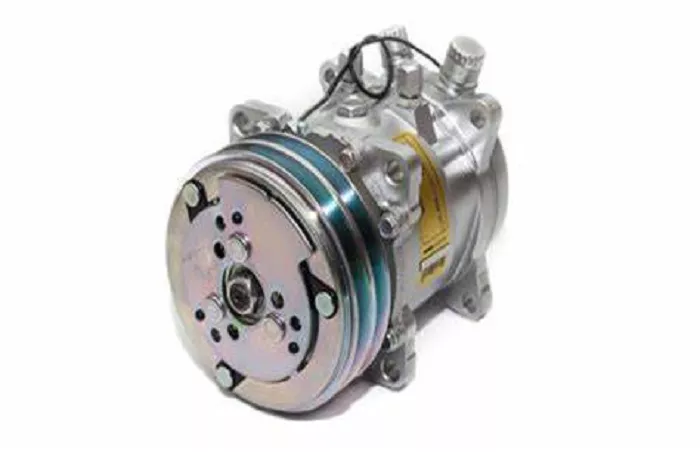Air conditioning (AC) compressors are the heart of any refrigeration or cooling system. They play a crucial role in compressing refrigerant gas, increasing its pressure and temperature before it circulates through the system to release heat. There are four main types of AC compressors, each with unique designs, working principles, and applications.
Reciprocating Compressors
Overview
Reciprocating compressors are one of the oldest and most widely used types. They operate similarly to an internal combustion engine, using pistons driven by a crankshaft to compress refrigerant.
Working Principle
- The motor drives a piston inside a cylinder.
- As the piston moves downward, it creates suction, drawing refrigerant gas into the cylinder.
- When the piston moves upward, it compresses the gas, increasing its pressure.
- The high-pressure gas is then discharged into the condenser.
Types of Reciprocating Compressors
- Single-acting: Compression occurs on one side of the piston.
- Double-acting: Compression occurs on both sides of the piston, improving efficiency.
- Hermetic: The motor and compressor are sealed in a single unit (common in household ACs).
- Semi-hermetic: Allows for servicing without breaking the entire seal.
- Open-type: The compressor and motor are separate, connected via a belt or coupling (used in industrial applications).
Advantages
- High efficiency at full load.
- Simple construction, easy to repair.
- Suitable for high-pressure applications.
Disadvantages
- Noisy operation due to piston movement.
- Higher vibration levels.
- More moving parts mean higher wear and tear.
Applications
- Residential air conditioners.
- Commercial refrigeration.
- Industrial cooling systems.
Rotary Compressors
Overview
Rotary compressors are compact, lightweight, and efficient, making them ideal for small to medium cooling applications. They use rotating mechanisms instead of pistons for compression.
Working Principle
- A rotor with blades rotates inside a cylinder.
- The rotation creates suction, drawing refrigerant into the compression chamber.
- As the rotor turns, the refrigerant is compressed and discharged.
Types of Rotary Compressors
- Rotary Vane: Uses sliding vanes to create compression chambers.
- Rolling Piston (Single Rotor): A roller rotates eccentrically inside a cylinder, compressing gas against the cylinder wall.
Advantages
- Compact and lightweight.
- Smooth, quiet operation.
- Fewer moving parts than reciprocating compressors.
- Energy-efficient for small cooling loads.
Disadvantages
- Limited capacity range.
- Less efficient for high-pressure applications.
- Wear on vanes or rollers over time.
Applications
- Window AC units.
- Small split AC systems.
- Refrigerators and dehumidifiers.
Overview
Screw compressors are widely used in large commercial and industrial HVAC systems. They use two interlocking helical rotors to compress refrigerant.
Working Principle
- Two rotors (male and female) mesh together inside a housing.
- Refrigerant enters at the suction side and gets trapped between the rotors.
- As the rotors turn, the gas is compressed and pushed toward the discharge port.
Types of Screw Compressors
- Oil-injected: Oil is used for sealing and cooling (common in industrial applications).
- Oil-free: Uses water or other methods for cooling (used in sensitive environments like pharmaceuticals).
Advantages
- High capacity, suitable for large systems.
- Continuous smooth operation with minimal vibration.
- Energy-efficient at full and partial loads.
- Long lifespan with proper maintenance.
Disadvantages
- High initial cost.
- Complex maintenance requirements.
- Requires skilled technicians for servicing.
Applications
- Large commercial buildings.
- Industrial refrigeration.
- Chiller plants.
Comparison of the 4 Compressor Types
| Feature | Reciprocating | Scroll | Rotary | Screw |
|---|---|---|---|---|
| Efficiency | High at full load | High at partial load | Moderate | High at all loads |
| Noise Level | High | Low | Low | Moderate |
| Maintenance | Moderate | Low | Low | High |
| Cost | Low | Moderate | Low | High |
| Capacity Range | Small to Large | Small to Medium | Small | Large |
| Lifespan | Moderate | Long | Moderate | Long |
Conclusion
Choosing the right compressor depends on factors like system size, noise tolerance, budget, and maintenance capabilities. Understanding these four types helps HVAC professionals and consumers make informed decisions for optimal cooling performance.By selecting the appropriate compressor, you can ensure energy efficiency, longevity, and reliable operation in any air conditioning or refrigeration system.

